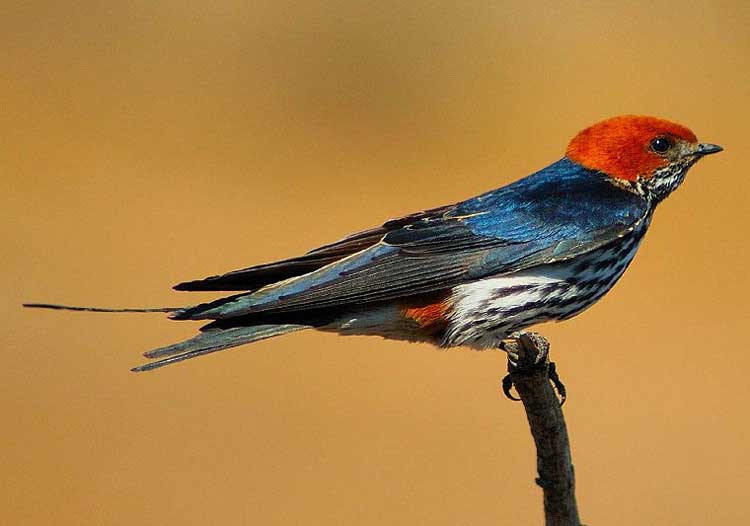
Cecropis abyssinica (*)
Superregnum: Eukaryota
Cladus: Unikonta
Cladus: Opisthokonta
Cladus: Holozoa
Regnum: Animalia
Subregnum: Eumetazoa
Cladus: Bilateria
Cladus: Nephrozoa
Superphylum: Deuterostomia
Phylum: Chordata
Subphylum: Vertebrata
Infraphylum: Gnathostomata
Megaclassis: Osteichthyes
Cladus: Sarcopterygii
Cladus: Rhipidistia
Cladus: Tetrapodomorpha
Cladus: Eotetrapodiformes
Cladus: Elpistostegalia
Superclassis: Tetrapoda
Cladus: Reptiliomorpha
Cladus: Amniota
Classis: Reptilia
Cladus: Eureptilia
Cladus: Romeriida
Subclassis: Diapsida
Cladus: Sauria
Infraclassis: Archosauromorpha
Cladus: Crurotarsi
Divisio: Archosauria
Cladus: Avemetatarsalia
Cladus: Ornithodira
Subtaxon: Dinosauromorpha
Cladus: Dinosauriformes
Cladus: Dracohors
Cladus: Dinosauria
Ordo: Saurischia
Cladus: Eusaurischia
Subordo: Theropoda
Cladus: Neotheropoda
Cladus: Averostra
Cladus: Tetanurae
Cladus: Avetheropoda
Cladus: Coelurosauria
Cladus: Tyrannoraptora
Cladus: Maniraptoromorpha
Cladus: Maniraptoriformes
Cladus: Maniraptora
Cladus: Pennaraptora
Cladus: Paraves
Cladus: Eumaniraptora
Cladus: Avialae
Infraclassis: Aves
Cladus: Euavialae
Cladus: Avebrevicauda
Cladus: Pygostylia
Cladus: Ornithothoraces
Cladus: Ornithuromorpha
Cladus: Carinatae
Parvclassis: Neornithes
Cohors: Neognathae
Cladus: Neoaves
Cladus: Telluraves
Cladus: Australaves
Ordo: Passeriformes
Subordo: Passeri
Infraordo: Passerida
Superfamilia: Sylvioidea
Familia: Hirundinidae
Genus: Cecropis
Species: Cecropis abyssinica
Subspecies: C. a. abyssinica - C. a. ampliformes - C. a. bannermani - C. a. maxima - C. a. puella - C. a. unitatis
Name
Cecropis abyssinica Guerin-Meneville, 1843
Synonyms
Hirundo abyssinica
References
Revue Zoologique, par la Société Cuvierienne 6 p. 322
Vernacular names
Afrikaans: Kleinstreepswael
čeština: Vlaštovka menší
English: Lesser Striped Swallow
français: Hirondelle striée
polski: Jaskółka abisyńska
The lesser striped swallow (Cecropis abyssinica) is a large swallow. It breeds in Sub-Saharan Africa from Sierra Leone and southern Sudan south into eastern South Africa. It is partially migratory with South African birds wintering further north. West African birds leave the north of the breeding range in the dry season.
Habitat
This is a bird of wooded, mainly lowland habitats. The lesser striped swallow prefers less open habitats, and is replaced in montane grassland by the greater striped swallow, Hirundo cucullata. It is common and often found around human habitation.
Description
H. a. unitatis in flight in KwaZulu-Natal
The lesser striped swallow is 15–10 cm long. It has dark blue upperparts with a red rump and a rufous-chestnut crown, nape and sides of the head. The underparts are white with dark streaking, and the upper wings and underwing flight feathers are blackish-brown. The underwing coverts are tawny. The blackish tail has very long outer feathers; these are slightly longer in the male than the female. Juveniles are duller and browner, with less contrast and shorter outer tail feathers. There are five or six subspecies differing in the extent of the underpart streaking.
The lesser striped swallow has heavier and darker underparts striping, a deeper red rump, and a brighter head colour than the larger greater striped swallow.
Behavior
It feeds mainly on flying insects, but has been known to eat small fruits. The flight is erratic, and the call is a nasal zeh zeh zeh zeh zeh.
Breeding
The lesser striped swallow builds a bowl-shaped mud nest with a tubular entrance on the underside of a suitable structure. The nest has a soft lining, and may be reused in later years. The nest may be built in a cave, under a rock overhang or a tree branch. This species has benefited from its willingness to use buildings, bridges, culverts and similar structures. Given the choice, it will select a high nest site.
The eggs are glossy white sometimes with a few brown spots; three eggs are a typical clutch. Incubation is by the female alone for 14–16 days to hatching. Both parents then feed the chicks. Fledging takes another 17–19 days, but the young birds will return to the nest to roost for a few days after their first flight.
References
BirdLife International (2017) [amended version of 2016 assessment]. "Cecropis abyssinica". IUCN Red List of Threatened Species. 2017: e.T22712350A111068375. doi:10.2305/IUCN.UK.2017-1.RLTS.T22712350A111068375.en. Retrieved 7 March 2022.
Sinclair, Hockey and Tarboton, SASOL Birds of Southern Africa, ISBN 1-86872-721-1
Turner and Rose, Swallows and Martins ISBN 0-7470-3202-5
Retrieved from "http://en.wikipedia.org/"
All text is available under the terms of the GNU Free Documentation License

